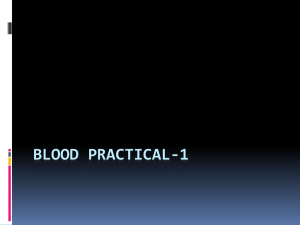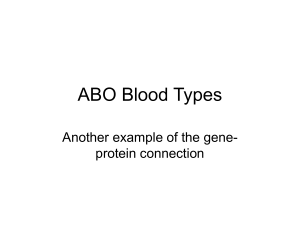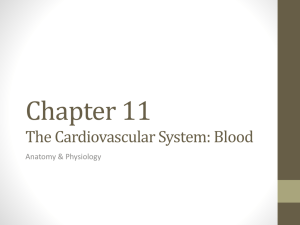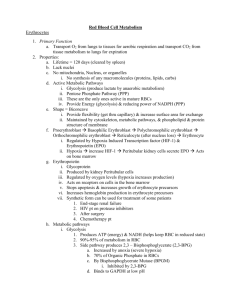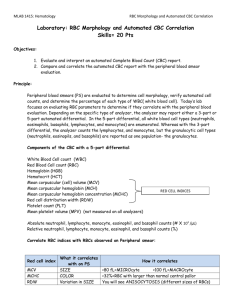Research Statement - University of Pittsburgh
advertisement
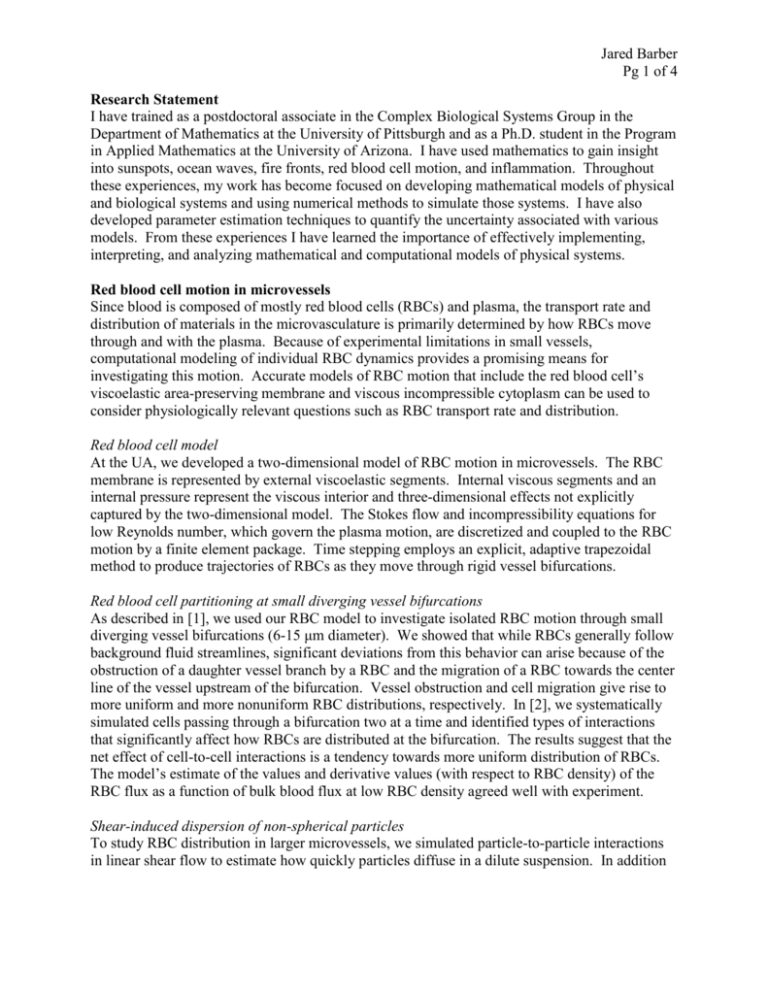
Jared Barber Pg 1 of 4 Research Statement I have trained as a postdoctoral associate in the Complex Biological Systems Group in the Department of Mathematics at the University of Pittsburgh and as a Ph.D. student in the Program in Applied Mathematics at the University of Arizona. I have used mathematics to gain insight into sunspots, ocean waves, fire fronts, red blood cell motion, and inflammation. Throughout these experiences, my work has become focused on developing mathematical models of physical and biological systems and using numerical methods to simulate those systems. I have also developed parameter estimation techniques to quantify the uncertainty associated with various models. From these experiences I have learned the importance of effectively implementing, interpreting, and analyzing mathematical and computational models of physical systems. Red blood cell motion in microvessels Since blood is composed of mostly red blood cells (RBCs) and plasma, the transport rate and distribution of materials in the microvasculature is primarily determined by how RBCs move through and with the plasma. Because of experimental limitations in small vessels, computational modeling of individual RBC dynamics provides a promising means for investigating this motion. Accurate models of RBC motion that include the red blood cell’s viscoelastic area-preserving membrane and viscous incompressible cytoplasm can be used to consider physiologically relevant questions such as RBC transport rate and distribution. Red blood cell model At the UA, we developed a two-dimensional model of RBC motion in microvessels. The RBC membrane is represented by external viscoelastic segments. Internal viscous segments and an internal pressure represent the viscous interior and three-dimensional effects not explicitly captured by the two-dimensional model. The Stokes flow and incompressibility equations for low Reynolds number, which govern the plasma motion, are discretized and coupled to the RBC motion by a finite element package. Time stepping employs an explicit, adaptive trapezoidal method to produce trajectories of RBCs as they move through rigid vessel bifurcations. Red blood cell partitioning at small diverging vessel bifurcations As described in [1], we used our RBC model to investigate isolated RBC motion through small diverging vessel bifurcations (6-15 μm diameter). We showed that while RBCs generally follow background fluid streamlines, significant deviations from this behavior can arise because of the obstruction of a daughter vessel branch by a RBC and the migration of a RBC towards the center line of the vessel upstream of the bifurcation. Vessel obstruction and cell migration give rise to more uniform and more nonuniform RBC distributions, respectively. In [2], we systematically simulated cells passing through a bifurcation two at a time and identified types of interactions that significantly affect how RBCs are distributed at the bifurcation. The results suggest that the net effect of cell-to-cell interactions is a tendency towards more uniform distribution of RBCs. The model’s estimate of the values and derivative values (with respect to RBC density) of the RBC flux as a function of bulk blood flux at low RBC density agreed well with experiment. Shear-induced dispersion of non-spherical particles To study RBC distribution in larger microvessels, we simulated particle-to-particle interactions in linear shear flow to estimate how quickly particles diffuse in a dilute suspension. In addition Jared Barber Pg 2 of 4 to obtaining results that agree with three-dimensional studies on rigid particles, our results also suggested that particle flexibility and shape do not significantly affect particle diffusivity. Models of inflammation An acute inflammatory response can be triggered by trauma or severe infection. While its primary function is to eliminate invading pathogens and promote tissue healing, the inflammatory response can also produce collateral tissue damage. The balance between the benefits and detriments of the inflammatory response determines the dynamics of a disease and what intervention strategies may prove helpful. Building on previous ordinary differential equation models, we have implemented partial differential equation models of the immune response to more fully understand this balance and its dependence on spatial heterogeneity. Necrotizing enterocolitis Necrotizing enterocolitis (NEC) is a devastating disease affecting premature infants in which bacteria that normally reside in the intestine are able to permeate the intestinal lining and invoke an immune response in the underlying tissue. In [3], we developed a three-dimensional computational model of NEC consisting of ten partial differential equations that were solved using central differences and upwinding for spatial discretization of diffusion and chemotaxis operators, respectively, and forward Euler in time. The model reproduced experimental results that showed the positive effect of breast-milk on the patient’s outcome. The model also showed that the outcome of a patient can depend on the shape of the affected area. To estimate some of the unknown parameter values, we compared the partial differential equation dynamics of the intestinal lining with time lapse photographs of an in vitro epithelial cell experiment [4]. To find a set of parameters that successfully reproduce the two-dimensional data, we developed versions of the Kalman filter that employ sparse grid stochastic collocation and the Karhunen-Loeve expansion. These methods are Matlab-based and exploit Matlab’s parallel processing capabilities. Kalman filter methods usually take a running temporal model and periodically update it by using experimental data. Sparse grid stochastic collocation efficiently and accurately integrates functions over multi-dimensional stochastic space by using a weighted sum of the values of the integrand at strategically placed points in stochastic space. The Karhunen-Loeve expansion can be thought of as an eigenfunction expansion of stochastic functions over an interval. Sparse grid collocation efficiently yields accurate expected values and variances of variables and parameters in the system necessary for the Kalman filter update step. The Karhunen-Loeve expansion allows us to exploit the fact that model error on the computational grid is spatially correlated. For moderately sized problems, our results show that these methods can be more efficient than many other traditional parameter estimation techniques. Pneumonia Pneumonia is an inflammatory condition in the lung with high mortality rates in immunocompromised individuals. We adapted our NEC model [3] to the lung by keeping using only five of the original ten variables [5]. Lung tissue, when inflamed, can more easily expand than other tissues because it can expand into highly compressible regions that are usually occupied by air. To model this, we introduced spatially varying diffusivities that depend on the amount of inflammation in a given region. We have developed this model alongside a homogenized ordinary differential equation model and used steady state analysis and multiple simulations to Jared Barber Pg 3 of 4 obtain a range of possible parameter values that produce physiologically realistic behavior. Preliminary results also show that spatial effects such as chemotaxis of immune cells and spatial heterogeneity in the system can enhance the effectiveness of the immune system. Future work Red blood cell motion I plan to extend the RBC model to consider the effects of the endothelial surface layer, a protein layer that coats microvessels and acts as a porous medium. This involves carefully coupling porous flow near the edge of the vessel to Stokes flow and tracking the boundary of the endothelial surface layer when RBCs impinge upon it. I will also plan to develop a similar of RBCs moving in plasma that can be used to consider RBC partitioning, particle diffusion, and the endothelial surface layer in a three-dimensional setting. Inflammation modeling I will extend our current NEC model to investigate and compare current competing theories on how NEC is instigated. Also, I plan to further explore the implications of spatial inhomogeneities on the dynamics of NEC by incorporating more of the details of the spatial structure of the intestine including the undulating structure of the intestinal lining, an antibacterial mucous layer that coats the intestinal lining in an inhomogeneous fashion, and the structure of the intestinal vasculature. Incorporating such spatial details will require parallel computing and switching from a rectilinear to a curvilinear grid. I also plan to more thoroughly classify how spatial effects alter the effectiveness of the immune system and use the model to investigate how we can best improve the health of a patient with pneumonia. Parameter estimation I plan to use the methods we have developed to help improve parameter estimates for both the NEC and Lung model. While these methods show promise, it is important to know when these methods do not work and why. We are currently analyzing how performance of these methods depends on the amount of data available, the sensitivity of the solution to the parameters, and the amount of error in the model and experimental measurements. I also plan to implement less efficient but more accurate parameter estimation techniques (e.g. Markov chain Monte Carlo methods) to help assess the capabilities of our Kalman filter techniques. This will include developing surrogate/response surface models for use with such methods. In addition, my experience with Matlab’s parallel and gpu processing tools on a single multi-core desktop suggest that feasible parameter estimation using other techniques with our biological models will require use of parallel computing on multiple machines. Summary My work on computational models of RBC motion, necrotizing enterocolitis, pneumonia, and parameter estimation has shown me the potential for applied mathematics to provide insight into physical and biological problems. This potential cannot be reaped by mathematics alone and thus, I have worked with scientists in multiple disciplines in order to understand more fully the details of each problem. As I continue in my research, I plan to continue collaborating across disciplines in order to develop accurate and informative computational models of complex biological systems. Jared Barber Pg 4 of 4 References 1. Barber, JO, Alberding, JP, Restrepo, JM, and Secomb, TW. Simulated twodimensional red blood cell motion, deformation, and partitioning in microvessel bifurcations. Ann.Biomed.Eng. 36: 1690-1698, 2008. 2. Barber, JO, Restrepo, JM, and Secomb, TW. Simulated red blood cell motion in microvessel bifurcation: Effects of cell-cell interactions on cell partitioning. (Accepted in Cardiovascular Engineering and Technology.) 3. Barber, JO, Tronzo, M, Horvat, C, Clermont, G, Upperman, J, Vodovotz, Y, Yotov, I. A three-dimensional mathematical and computational model of necrotizing enterocolitis. (Submitted.) 4. Barber, JO, Yotov, I. Parameter estimation for a nonlinear diffusion model of epithelial cell migration using stochastic collocation and the Karhunen-Loeve expansion. (In preparation.) 5. Barber, JO, Clermont, G, Yotov, I. A three-dimensional model of inflammation in the lung: Parameter estimation and in vivo comparison. (In preparation.)

